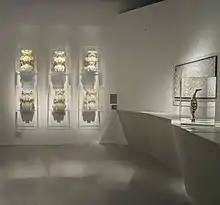Morphogenèse numérique
La morphogenèse numérique est un processus de développement de la forme (ou morphogenèse[note 1]) grâce au calcul par ordinateur. Même si ce concept est applicable dans beaucoup de domaine, le terme « morphogenèse numérique » a tout d'abord été utilisé en architecture.

En architecture, la morphogenèse numérique est un groupe de méthodes qui emploient les médias numérique pour façonner la forme et l'adapter plutôt que pour la représentation, souvent lors d'une inspiration pour exprimer ou pour répondre à un processus contextuel[1] - [2] - [3] - [4].
« Dans cette perspective inclusive, la morphogenèse numérique en architecture porte une grande partie analogue ou une relation métaphorique avec les processus de morphogenèse dans la nature, partager avec elle la dépendance à l'égard du développement progressif mais n'adopte pas ni ne réfère nécessairement aux mécanismes actuel de croissance ou d'adaptation. De récents discours ont lié la morphogenèse numérique en architecture à un nombre de concepts tel que l'émergence, l'auto-organisation et la recherche de forme »
— Stanislav Roudavski, Towards Morphogenesis in Architecture[5].
Notes et références
Notes
- L'usage initial du terme a été dans le domaine de la biologie. Son usage en géologie a aussi été établi, cf. geomorphologie.
Références
- Kolarevic 2000, p. ?
- (en) Branko Kolarevic et Ali Malkawi, Performative Architecture: Beyond Instrumentality, New York, Londres, Spon Press, , p. 195
- Leach 2009, p. ?
- Roudavski 2009, p. 348
- Roudavski 2009, p. 348-349.
Bibliographie
![]() : document utilisé comme source pour la rédaction de cet article.
: document utilisé comme source pour la rédaction de cet article.
- (en) Jane Burry et al., « Dynamical Structural Modeling: A Collaborative Design Exploration », International Journal of Architectural Computing, vol. 3, no 1, , p. 27-42
- (en) Manuel De Landa, A Thousand Years of Nonlinear History, New York, Zone Books,
- (en) Günther Feuerstein, Biomorphic Architecture: Human and Animal Forms in Architecture, Stuttgart; Londres, Axel Menges,
- (en) John H. Frazer, An Evolutionary Architecture, Themes VII, Londres, Architectural Association, (présentation en ligne)
- (en) Michael Hensel et Achim Menges, « Designing Morpho-Ecologies: Versatility and Vicissitude of Heterogeneous Space », Architectural Design, vol. 78, no 2, , p. 102–111
- (en) Michael Hensel, Achim Menges et Michael Weinstock, « Emergence: Morphogenetic Design Strategies », Architectural Design, londres, Wiley,
- (en) Michael Hensel et Achim Menges, « Material and Digital Design Synthesis », Architectural Design, vol. 76, no 2, , p. 88–95
- (en) Michael Hensel et Achim Menges, « Differentiation and Performance: Multi-Performance Architectures and Modulated Environments », Architectural Design, vol. 76, no 2, , p. 60–69
- Hingston, Philip F., Luigi C. Barone, and Zbigniew Michalewicz, eds (2008). Design by Evolution: Advances in Evolutionary Design (Berlin; London: Springer)
 (en) Branko Kolarevic, « Digital Morphogenesis and Computational Architectures », Proceedigns of the 4th Conference of Congreso Iberoamericano de Grafica Digital, SIGRADI 2000 - Construindo (n)o Espaço Digital, Rio de Janeiro (Brésil), José Ripper Kós, Andréa Pessoa Borde et Diana Rodriguez Barros, , p. 98-103 (lire en ligne)
(en) Branko Kolarevic, « Digital Morphogenesis and Computational Architectures », Proceedigns of the 4th Conference of Congreso Iberoamericano de Grafica Digital, SIGRADI 2000 - Construindo (n)o Espaço Digital, Rio de Janeiro (Brésil), José Ripper Kós, Andréa Pessoa Borde et Diana Rodriguez Barros, , p. 98-103 (lire en ligne) (en) Neil Leach, « Digital Morphogenesis », Architectural Design, vol. 79, no 1, , p. 32–37
(en) Neil Leach, « Digital Morphogenesis », Architectural Design, vol. 79, no 1, , p. 32–37- Lynn, Greg (1999). Animate Form (New York: Princeton Architectural Press)
- Lynn, Greg (1998). Folds, Bodies & Blobs: Collected Essays (Bruxelles: La Lettre volée)
- Menges, Achim (2007). « Computational Morphogenesis: Integral Form Generation and Materialization Processes », in Proceedigns of Em‘body’ing Virtual Architecture: The Third International Conference of the Arab Society for Computer Aided Architectural Design (ASCAAD 2007), 28–30 November 2007, Alexandria, Egypt, ed. by Ahmad Okeil, Aghlab Al-Attili and Zaki Mallasi, pp. 725–744
- Menges, Achim (2006). « Polymorphism », Architectural Design, 76, 2, pp. 78–87
- Ottchen, Cynthia (2009). 'The Future of Information Modelling and the End of Theory: Less is Limited, More is Different', Architectural Design, 79, 2, pp. 22–27
- Prusinkiewicz, Przemyslaw, and Aristid Lindenmayer (2004). The Algorithmic Beauty of Plants (New York: Springer-Verlag)
 (en) Stanislav Roudavski, « Towards Morphogenesis in Architecture », International Journal of Architectural Computing, vol. 7, no 3, , p. 345–374 (lire en ligne)
(en) Stanislav Roudavski, « Towards Morphogenesis in Architecture », International Journal of Architectural Computing, vol. 7, no 3, , p. 345–374 (lire en ligne)- Sabin, Jenny E. and Peter Lloyd Jones (2008). 'Nonlinear Systems Biology and Design: Surface Design', in Proceedings of the 28th Annual Conference of the Association for Computer Aided Design in Architecture (ACADIA), Silicon + Skin: Biological Processes and Computation, Minneapolis 16–19 October 2008, ed. by Andrew Kudless, Neri Oxman and Marc Swackhamer, pp. 54–65
- Sevaldson, Birger (2005). Developing Digital Design Techniques: Investigations on Creative Design Computing (PhD, Oslo School of Architecture)
- Sevaldson, Birger (2000). « Dynamic Generative Diagrams », in Promise and Reality: State of the Art versus State of Practice in Computing for the Design and Planning Process. 18th eCAADe Conference Proceedings, ed. by Dirk Donath (Weimar: Bauhaus Universität), pp. 273–276
- Steadman, Philip (2008). The Evolution of Designs: Biological Analogy in Architecture and the Applied Arts (New York: Routledge)
- Tierney, Therese (2007). Abstract Space: Beneath the Media Surface (Oxon: Taylor & Francis), p. 116
- Weinstock, Michael (2006). « Self-Organisation and the Structural Dynamics of Plants », Architectural Design, 76, 2, pp. 26–33
- Weinstock, Michael (2006). « Self-Organisation and Material Constructions », Architectural Design, 76, 2, pp. 34–41